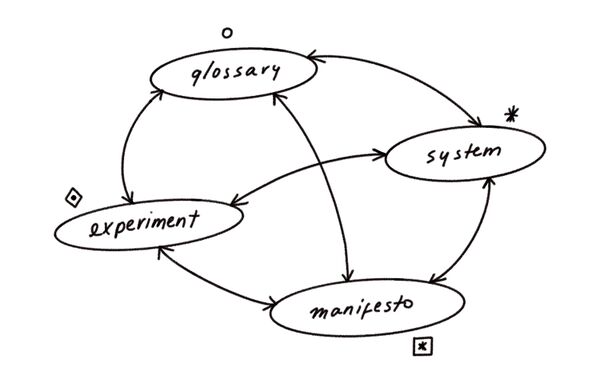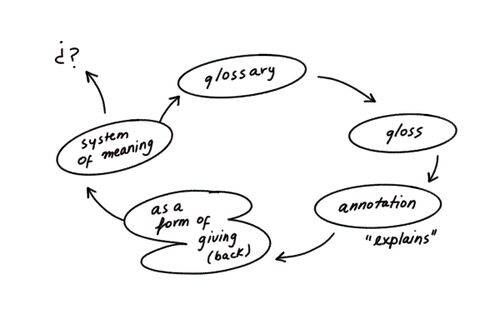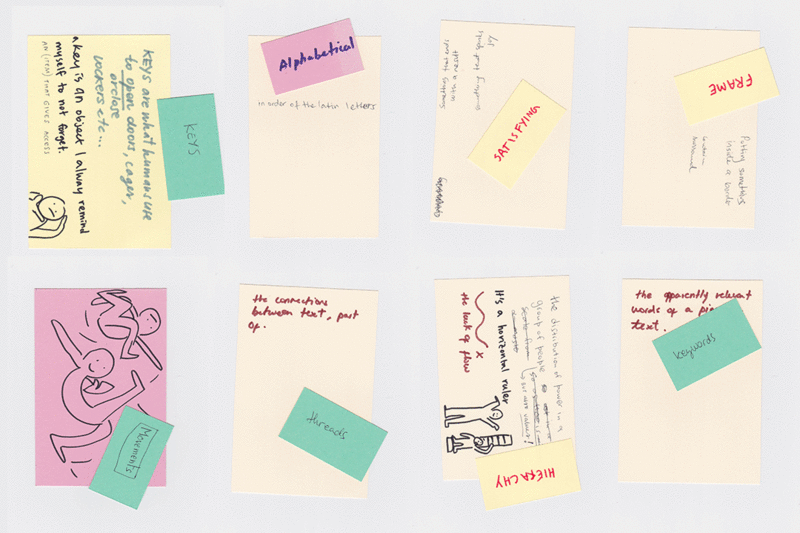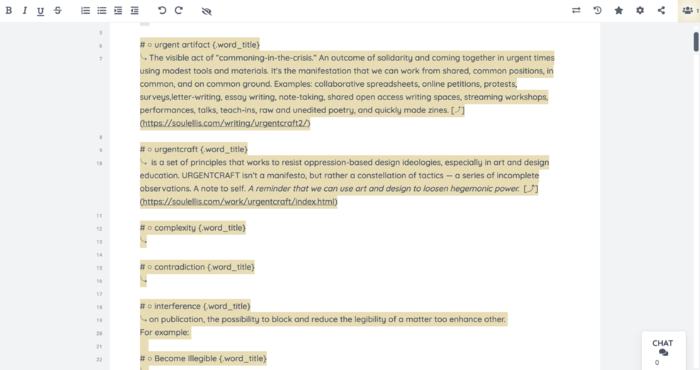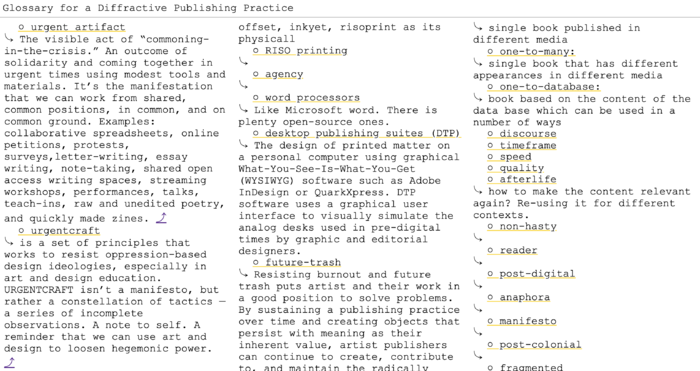User:Camilo/Project Proposal: Difference between revisions
| Line 178: | Line 178: | ||
:: Those words give the idea to self-host the project by collectively learning how to set up a web server in a Raspberry pi as the infrastructure. | :: Those words give the idea to self-host the project by collectively learning how to set up a web server in a Raspberry pi as the infrastructure. | ||
See a expanded explanation [[User:Camilo/Thesis Guideline|Here]] | |||
==<p style="color:black; font-family: Alike Angular; font-size: 20pt; font-weight: bold;">↺. Who can help me and how? </p>== | ==<p style="color:black; font-family: Alike Angular; font-size: 20pt; font-weight: bold;">↺. Who can help me and how? </p>== | ||
Revision as of 16:16, 22 November 2021
↺. Project Proposal
Working title: Glossary for a diffractive publishing practice
↺. What do I want to make, and Why?
I'm currently starting a small publishing project with my friend Maria Paris called attempt. Together, in collaboration with different artists, we have released three publications in the realm of arts. One photo book, one trio of speculative fiction tales, and an essay that reflects on translation and distance. The project I'm proposing to make would be the continuity of this collaboration with her and it would map and expand our practice by speculating possible paths for future publications.
This project is a hybrid and bilingual publication that is simultaneously a glossary, a system, an experiment, and a manifesto.
○ glossary ---> as the matter ---> It is composed of words and their annotations.
✴︎ system ---> as the form ---> It tends to organize itself as a complex system. A system fundamentally open, unpredictable, non-linear, adaptative, mutable...
◈ experiment ---> as the movement. It activates itself by trying out.
⧆ manifesto ---> as the intention ---> It reflects and declare possible statements.
Therefore, it is a publication that challenges the idea of a glossary as its own core by conceiving it as a system of never-ending defined words. It is an interconnected system of words activated by trying out and speculating on possible connections among each other. It is an experiment to manifest reflections on possible futures for small-publishing practices on arts.
The plan is to gather a system of words and their annotations to cross-references between different sources in English and Spanish. These vocabularies come from the already existing publishing books I've been reading (↓ see book sources), publishing projects I'm interested in (↓ see project sources), past publishing experiences I was part of (↓ see experience sources), and other vocabularies inside other realms I find relevant to connect to the research (↓ see expanded sources). This experiment aims to activate a conversation between sources in different languages and discourses by highlighting problematics, bringing up questions, and experimenting over processes, results, and infrastructure of the practice.
In the end, this project is an attempt to state paths inside my own publishing practice, because I believe it is necessary to state missions as contemporary actors inside the publishing realm by reflecting on it and taking responsibility over it. Although this path may be one and multiples at the same time, those have to come with the strong idea of 'creating with' in a collective interconnected world.
↺. How do I plan to make it, and When?
Given the big scope of the project and being aware of its never-ending nature. I'm planning to organize it through different stages, and present them as states of the process.
Each state run in parallel different processes related to every component of the project. These are marked in the timetable with different symbols (○ glossary, ✴︎ system, ◈ experiment, ⧆ manifesto), and they are framed in a period of time during the semester.
↺. Time Table
////////////////////////////////////////////////////////////////////////////////////////////////// STATE 1 //////////////////////////////////////////////////////////////////////////////////////////////////
October {
- [✓] ○. Individually gather and annotate words from the list of sources. Create a workflow (see ↺.✴︎.)
- [✓] ○.◈. Event: (11 Oct) Aquarium 1.0: A small ecosystem of living thoughts. Workshop "Glossary of glossaries" (see ↺.○.◈.).
}
November {
- [✓] ○. Individually gather and annotate words from the list of sources.
- [✓] ◈. Prototyping layouts (see ↺.✴︎.)
- [✓] ⧆. ◈. Creating the infrastructure to self-host the project (see ↺. ⧆ ~ ◈.)
- [] ○.◈. Event: (29 Nov) Aquarium 2.0: A small ecosystem of living thoughts. Publish "A brief Glossary of Glossaries" digesting the results of the first Aquarium
- [] ⧆. Choosing a limited amount of sources to harvest by conversing with Maria
}
December {
- [] ○. Individually gather and annotate words from the list of sources.
- [] △. ✴︎. Prototyping. Playing with the current state of the system.
- [] ⧆. ◈. Debugging the infrastructure to self-host the project.
- [] ⟡. Pausing the individual gathering and converse with Maria the current state of words to continue.
}
↺. State 1 Outputs:
- Self-host Infrastructure
- 1. Self-host public server (rpi)
- 2. Self-host etherpad instance
- Workflow to gather and annotate the words
- Selection of Sources
- "A Brief Glossary of Glossaries"
////////////////////////////////////////////////////////////////////////////////////////////////// STATE 2 //////////////////////////////////////////////////////////////////////////////////////////////////
January {
- [] ○. ✴︎. ◈. sort them with a visual system of symbols to cross-references and start weaving (see ↺. ⧆ ~ ◈.).
- [] ○. ✴︎. ◈. ⧆. Make the glossary public by asking people to contribute with annotations over the words using the pad. (see 'who can help me' section)
- [] ○. ✴︎. ◈. Prototyping. Experiment with the current state of the system by testing the open-system possibilities.
}
February {
- [] ○. ✴︎. Keep on collectively gathering annotations over the words to open the system.
- [] ○. ✴︎. ◈. Prototyping. Experiment with the current state of the system by testing the open-system possibilities with the multiple annotations structure.
}
March {
- [] ○. ◈. ⧆. Converse with Maria and activate the Glossary by thinking ways to make public the current state of the project. (see ↺.◈.⧆.)
- [] ○. ◈. ✴︎. Prototyping. Web-to-print layout experimentation.
}
↺. State 2 Outputs:
- Visual system of symbols
- Collective annotation session over the words
- Experiments on the Openness of the project.
- Proposal of the first printed version of it (if it's the case).
////////////////////////////////////////////////////////////////////////////////////////////////// STATE 3 //////////////////////////////////////////////////////////////////////////////////////////////////
April {
- [] ○. ◈. ✴︎. ⧆. Prototyping/Press. Web-to-print layout experimentation. Space to debug and start revising and proof prints
}
May {
- [] ○. ◈. ✴︎. ⧆. Prototyping/Press. Trying out the publication. Space to debug and print.
}
June {
- [] ○. ◈. ✴︎. ⧆. Prototyping/Press. Trying out the publication. Space to debug and bind.
- [] ○. 24th: Graduation Show
- For that day I imagine presenting the project as an installation/constellation of the three state outcomes of the current process.
}
↺. State 3 Outputs:
- a first printed version of a Glossary for a diffractive publishing practice
↺.⟡. Challenging the glossary structure
The glossary is a common element in a book structure. It is there to clarify terminology, but also to create meaning and sense inside the book. It's typically the same structure always: a list of terms in alphabetical order placed at the beginning of the end of it.
But furthermore, the word glossary comes from the term 'gloss' that means annotation and also layer. Then a glossary can also be a sort of 'layering of annotations'. Annotations that from my perspective are gestures of reciprocity. From the reader to the text.
Therefore to challenge the idea of the glossary itself and approach it as a layering of annotations, I plan to unpack its structure and recognize which aspects of it are useful and which ones would be interesting to experiment with.
Some of the questions I'm planning to reflect on in this stage of the process are:
- ↺ What does it mean conceptually to write down a list of terms, words, and explanations?
- ↺ How a vertical and closed structure of terminology can be conceived as a horizontal and open one?
- ↺ What is the voice of these annotations on the words, who is speaking?
- ↺ When constructing knowledge, how to not prioritize written language?
↺.⟡.◈. 'Glossary of Glossaries: An exploratory collective workshop'
As a HackPack that explored the glossary structure, I proposed a collective workshop of making a 'glossary of glossaries' by collecting, reflecting, writing, and annotating on glossaries.
Outputs from the workshop to experiment with during the project:
- ↺. The alphabetical hierarchy
- ↺. Explanation beyond written Language
- ↺. The location of it inside a publication
- ↺. The power of collective & multiple interpretations
↺.●. Gathering Nodes
The words of the glossary have been gathered by an exercise of reading, surfing, and reflecting on the sources. I revisit them to write down on the pad the words and annotations I find relevant for the project. Some of them are tools, others are concepts, keywords, materials, or techniques.
So far, the structure of the glossary is a list of words with annotations in a non-alphabetical order. But the idea is in State 2, after being annotating on them for a while, to experiment on the layout and the organization of them based on the thoughts collected in the "Glossary of Glossaries". Although I still don't know how many words are going to be gathered, I am planning to talk with Maria at the end of December (see Time Table).
PAD: https://hub.xpub.nl/soupboat/pad/p/camilo_glossary
For the technical side, the workflow for gathering the material is using markdown, etherpad, pandoc, html and css. Concretely, I'm writing down all the words on a etherpad using markdown language and converting them into html using a python script that calls the markdown file via API and processes it with the library pandoc. This creates a website that is styled using css.
One of the intentions of the project is to start creating the glossary in a way that lets me manipulate and transform easily into different materials and mediums. That is why I'm using the web-to-print flow to be able to experiment with the words in a hybrid way.
URL: https://hub.xpub.nl/sandbot/~camilo/Glossary/
↺. ⧆ - ◈. Weaving threads
⧆ ~ ◈. Thread #1: How can I host my project?
Having in mind the question about the infrastructure of this project: How am I going to host it online? I tried to thread words of the glossary and came up with a thread that reflects on this idea.
- The Thread:
- * infrastructure, Rpi, web-server, autonomous-practice, self-hosting, collective learning.
- Those words give the idea to self-host the project by collectively learning how to set up a web server in a Raspberry pi as the infrastructure.
See a expanded explanation Here
↺. Who can help me and how?
Manetta and Michael can help me with the project on the technical side, but also be able to connect conceptually those technical decisions. Maria Paris, my publishing partner, is gonna be part of the process, but most of all with conceptual and editorial design. Also, I would like to talk with Femke Snelting, Florian Cramer, Pia Pol, Miriam Rasch, Paul Solellis, Silvio Larusso and Aymeric which I think can give me feedback during the process, because all of them have been part of the critical thought regarding publishing practices.
↺.What is the Relation with my previous practice?
Since the beginning of my career, I have been involved with printed matter by being part of different scenarios of publishing such as workshops, courses, art-book fairs, fanzine festivals, and exhibitions. I have had the possibility to exhibit, co-produce and collaborate with different agents into the realm by making and exploring the possibilities of publishing on arts.
My time coursing experimental publishing has brought me new tools and ideas that expand the publishing realm and its possibilities. Based on the very basic mean of publishing, I would like to share and circulate them using this project. Rather than come up with new and unique ideas, I would like to relate my previous practice by connecting past questions with present and future ones.
↺. What is the Relation to a larger context?
Inside the publishing practices, it is common to state your mission or intention using the form of a manifesto. The book Publishing manifestos, edited in 2018 by Miss Read in Berlin, is an example of it. I believe those are not sterile documents. I think those, by reflecting on the practice and doubting about its own existence, have the power to imagine the impact of art publishing over the world.
To have the possibility to reflect, experiment, and share possible paths of the practice, it is for me an opportunity to contribute in large to the thought around it. Maybe not with the intention of giving solutions, but by speculating on possible ways to re-imagine it.
↺. References and Sources
☞ References
- Publishing Manifestos - Miss read Berlin 2018
- Glossary of Undisciplinated Design - Spector Books
- Glossary of cognitive activism (for a not distant future) - Warren Neidich
- manifestos from https://manifestos.de/ - Andrea Sick
- The Geo financial Lexicon - Ed. Jack Clarke & Sami Hammana
- World Map - Lucia Dossin
☞ Book sources
- Soap - Fabio Morais
- Publicación independiente como plataforma de Urgencia
- Publishing Manifestos - Miss read Berlin 2018
- Glossary of Undisciplined Design - Spector Books
- Glossary of cognitive activism (for a not distant future) - Warren Neidich
- Here and Now? Explorations in urgent publishing - Institute of Network Cultures.
- From print to Ebooks a Hybrid Publishing Toolkit for the Arts - Institute of Network Cultures
- A Book to the future: a manifesto for book liberation - Hybrid Publishing Consortium
- Post-Digital print: The mutation of publishing since 1894 - Alessandro Ludovico
- The book - Stephane Mallarme
☞ Expanded Sources
- Pensar sistémico: una introducción al pensamiento sistémico - Jose Antonio Garciandía
- ATATA - Natalia Chavez Lopez, Hilda Moucharrafieh
- Diffracting Diffraction: Cutting Together-Apart - Karen Barad.
- Poetics of Relations - Eduard Glissant
- Meeting the universe halfway - Karen Barad
- Offline Matters: The less-Digital Guide to Creative Work - Jess Henderson
☞ Projects Sources
- Kayfa-ta
- Urgent Craft - Paul Soulellis
- Infrastructural-publishing
- TOOLKIT FOR COOPERATIVE, COLLECTIVE, AND COLLABORATIVE CULTURAL WORK
- Press Press
- Literatura y traducción
- Algoliteraty Publishing House
- Timeline-publishing
- WOR(L)DS FOR THE FUTURE Republishing Toolkit for an Imaginary Atlas
- I don't know where are we going but,
- Radio Implicancies
- Are.na page - A channel of projects I have found
☞ Experiences Sources
- Organising Zine Camp Festival
- Past art-book & fanzine fairs I was exhibiting in (Spread, Libros Mutantes, Missread, Graf, No tengo mama and P.A.G.E.S)
- Natural Convergence: Vegetal Communities Workshop (2017)webstite(Personal project)

